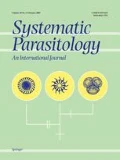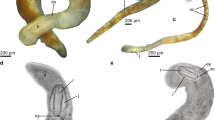Abstract
Specimens of the greasy grouper Epinephelus tauvina (Forsskål), caught off Moorea, French Polynesia, harboured four species of gill monogeneans. The diplectanid Pseudorhabdosynochus pai n. sp. is characterised by an extremely big male quadriloculate organ (inner length 77 μm, cone length 15, tube length 47), the largest of all members of the genus, and a sclerotised vagina with a very complex structure, including three secondary chambers instead of one as in most species. Pseudorhabdosynochus sp. is a species of the ‘cupatus group’; this species is not formally described but various measurements are provided. The ancyrocephalid Haliotrema sp. and the capsalid Benedenia sp. were rare; they are both mentioned but not described. The diplectanid fauna of E. tauvina corresponds to the pattern already found in a clade of grouper species, the members of which often harbour both a species of the ‘cupatus group’ and another species of Pseudorhabdosynochus Yamaguti, 1958.
Résumé
Des spécimens du mérou Epinephelus tauvina (Forsskål) pêchés à Moorea, Polynésie Française, hébergeaient quatre espèces de monogènes sur les branchies. Le Diplectanidae Pseudorhabdosynochus pai n. sp. est caractérisé par un organe tétraloculé mâle de très grande taille (longueur interne 77 μm, longueur du cône 15, longueur du tube 47), le plus grand de toutes les espèces du genre, et un vagin sclérifié à structure très complexe, comprenant trois chambres secondaires, au lieu d’une comme c’est le cas chez la plupart des autres espèces. Pseudorhabdosynochus sp. est une espèce du ‘groupe cupatus’ qui n’est pas formellement décrite, mais des mesures sont indiquées. Un Ancyrocephalidae, Haliotrema sp., et un Capsalidae, Benedenia sp., étaient rares, et sont mentionnés mais non décrits. La faune des Diplectanidae de E. tauvina correspond au patron déjà trouvé dans un clade d’espèces de mérous, dont les membres hébergent souvent à la fois une espèce du ‘groupe cupatus’ et une autre espèce de Pseudorhabdosynochus Yamaguti, 1958.





Similar content being viewed by others
References
Bondad-Reantaso, M. G., Kanchanakhan, S., & Chinabut, S. (2002). Review of grouper diseases and health management strategies for grouper and other marine finfish diseases. Paper presented at the Report of the Regional Workshop on Sustainable Seafarming and Grouper Aquaculture, Medan, Indonesia, 17–20 April 2000. Collaborative APEC Grouper Research and Development Network (FWG 01/99). APEC/NACA/BOBP/GOI, Network of Aquaculture Centres in Asia-Pacific, Bangkok, Thailand, 224 pp.
Craig, M. T., & Hastings, P. A. (2007). A molecular phylogeny of the groupers of the subfamily Epinephelinae (Serranidae) with a revised classification of the Epinephelini. Ichthyological Research, 54, 1–17.
Heemstra, P. C., & Randall, J. E. (1993). FAO Species Catalogue. Vol. 16. Groupers of the world (Family Serranidae, Subfamily Epinephelinae). An annotated and illustrated catalogue of the grouper, rockcod, hind, coral grouper and lyretail species known to date. Rome: FAO, Vol. 125, 382 pp.
Hinsinger, D. D., & Justine, J.-L. (2006a). The ‘Pseudorhabdosynochus cupatus group’ (Monogenea: Diplectanidae) on Epinephelus fasciatus, E. howlandi, E. rivulatus and E. merra (Perciformes: Serranidae) off New Caledonia, with descriptions of Pseudorhabdosynochus cyathus n. sp. and P. calathus n. sp. Systematic Parasitology, 64, 69–90.
Hinsinger, D. D., & Justine, J.-L. (2006b). Pseudorhabdosynochus venus n. sp. (Monogenea: Diplectanidae) from Epinephelus howlandi (Perciformes: Serranidae) off New Caledonia. Systematic Parasitology, 63, 155–160.
Hussain, N. A., & Higuchi, M. (1980). Larval rearing and development of the brown spotted grouper, Epinephelus tauvina (Forskål). Aquaculture, 19, 339–350.
Justine, J.-L. (2005a). Species of Pseudorhabdosynochus Yamaguti, 1958 (Monogenea: Diplectanidae) from Epinephelus fasciatus and E. merra (Perciformes: Serranidae) off New Caledonia and other parts of the Indo-Pacific Ocean, with a comparison of measurements of specimens prepared using different methods, and a description of P. caledonicus n. sp. Systematic Parasitology, 62, 1–37.
Justine, J.-L. (2005b). Pseudorhabdosynochus hirundineus n. sp. (Monogenea: Diplectanidae) from Variola louti (Perciformes: Serranidae) off New Caledonia. Systematic Parasitology, 62, 39–45.
Justine, J.-L. (2007a). Parasite biodiversity in a coral reef fish: Twelve species of monogeneans on the gills of the grouper Epinephelus maculatus (Perciformes: Serranidae) off New Caledonia, with a description of eight new species of Pseudorhabdosynochus (Monogenea: Diplectanidae). Systematic Parasitology, 66, 81–129.
Justine, J.-L. (2007b). Pseudorhabdosynochus argus n. sp. (Monogenea: Diplectanidae) from Cephalopholis argus, P. minutus n. sp. and Diplectanum nanus n. sp. from C. sonnerati and other monogeneans from Cephalopholis spp. (Perciformes: Serranidae) off Australia and New Caledonia. Systematic Parasitology, 68, 195–215.
Justine, J.-L. (2008a). Diplectanum parvus sp. nov. (Monogenea, Diplectanidae) from Cephalopholis urodeta (Perciformes, Serranidae) off New Caledonia. Acta Parasitologica, 53, 127–132.
Justine, J.-L. (2008b). Two new species of Pseudorhabdosynochus Yamaguti, 1958 (Monogenea: Diplectanidae) from the deep-sea grouper Epinephelus morrhua (Val.) (Perciformes: Serranidae) off New Caledonia. Systematic Parasitology, 71, 145–158.
Justine, J.-L. (2009). A redescription of Pseudorhabdosynochus epinepheli (Yamaguti, 1938), the type-species of Pseudorhabdosynochus Yamaguti, 1958 (Monogenea: Diplectanidae), and the description of P. satyui n. sp. from Epinephelus akaara off Japan. Systematic Parasitology, 72, 27–56.
Justine, J.-L., & Sigura, A. (2007). Monogeneans of the malabar grouper Epinephelus malabaricus (Perciformes, Serranidae) off New Caledonia, with a description of six new species of Pseudorhabdosynochus (Monogenea: Diplectanidae). Zootaxa, 1543, 1–44.
Kritsky, D. C., Jimenez-Ruiz, F. A., & Sey, O. (2000). Diplectanids (Monogenoidea: Dactylogyridea) from the gills of marine fishes of the Persian Gulf off Kuwait. Comparative Parasitology, 67, 145–164.
Lo, C. M., & Morand, S. (2001). Gill parasites of Cephalopholis argus (Teleostei: Serranidae) from Moorea (French Polynesia): site selection and coexistence. Folia Parasitologica, 48, 30–36.
Neifar, L., & Euzet, L. (2007). Five new species of Pseudorhabdosynochus (Monogenea: Diplectanidae) from the gills of Epinephelus costae (Teleostei: Serranidae). Folia Parasitologica, 54, 117–128.
Randall, J. E. (1964). Notes on the groupers of Tahiti, with description of a new serranid fish genus. Pacific Science, 18, 281–296.
Rasheed, V. M. (1989). Diseases of cultured brown-spotted grouper Epinephelus tauvina and silvery black porgy Acanthopagrus cuvieri in Kuwait. Journal of Aquatic Animal Health, 1, 102–107.
Rigby, M. C., Lo, C. M., Cribb, T. H., Euzet, L., Faliex, E., Galzin, R., et al. (1999). Checklist of the parasites of coral reef fishes from French Polynesia, with considerations on their potential role in these fish communities. Cybium, 23, 273–284.
Sigura, A., Chauvet, C., & Justine, J.-L. (2007). Pseudorhabdosynochus bacchus sp. nov. (Monogenea, Diplectanidae) from Epinephelus coeruleopunctatus (Perciformes, Serranidae) off New Caledonia. Acta Parasitologica, 52, 196–200.
Sigura, A., & Justine, J. L. (2008). Monogeneans of the speckled blue grouper, Epinephelus cyanopodus (Perciformes, Serranidae), from off New Caledonia, with a description of four new species of Pseudorhabdosynochus and one new species of Laticola (Monogenea: Diplectanidae), and evidence of monogenean faunal changes according to the size of fish. Zootaxa, 1695, 1–44.
Whittington, I. D. (2004). The Capsalidae (Monogenea : Monopisthocotylea): a review of diversity, classification and phylogeny with a note about species complexes. Folia Parasitologica, 51, 109–122.
Whittington, I. D., Deveney, M. R., & Wyborn, S. J. (2001). A revision of Benedenia Diesing, 1858 including a redescription of B. sciaenae (van Beneden, 1856) Odhner, 1905 and recognition of Menziesia Gibson, 1976 (Monogenea: Capsalidae). Journal of Natural History, 35, 663–777.
Yang, T., Kritsky, D. C., & Sun, Y. (2004). Revision of Allobenedenia Yamaguti, 1963 (Monogenoidea: Capsalidae) with the description of A. zhangi n. sp. from Epinephelus fasciatus (Teleostei: Serranidae) in the South China Sea. Systematic Parasitology, 59, 223–233.
Young, P. C. (1968). Ten new species of Haliotrema Johnston and Tiegs, 1922 (Monogenoidea: Dactylogyridae) from Australian fishes and a revision of the genus. Journal of Zoology, London, 154, 41–75.
Zeng, B., & Yang, T. (2007). Description of Pseudorhabdosynochus justinei n. sp. (Monogenea: Diplectanidae) and redescription of P. vagampullum (Young, 1969) Kritsky & Beverley-Burton, 1986 from the gills of the longfin grouper Epinephelus quoyanus (Valenciennes) (Perciformes: Serranidae) in Dapeng Bay, South China Sea. Systematic Parasitology, 66, 223–225.
Zhang, J. Y., Yang, T. B., & Liu, L. (2001). Monogeneans of Chinese marine fishes. Beijing: Agriculture Press, 400 pp.
Acknowledgements
Cyndie Dupoux, a student, skilfully prepared most of the slides used in this study. We are grateful to P. Ung for field assistance in Polynesia. CRIOBE facilities (UMR2978 CNRS EPHE) were used during this field expedition.
Author information
Authors and Affiliations
Corresponding author
Rights and permissions
About this article
Cite this article
Justine, JL., Vignon, M. Monogeneans of the grouper Epinephelus tauvina (Perciformes, Serranidae) off Moorea, French Polynesia, with a description of Pseudorhabdosynochus pai n. sp. (Monogenea: Diplectanidae). Syst Parasitol 72, 113–125 (2009). https://doi.org/10.1007/s11230-008-9159-1
Received:
Accepted:
Published:
Issue Date:
DOI: https://doi.org/10.1007/s11230-008-9159-1




